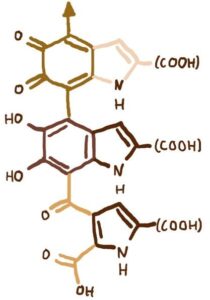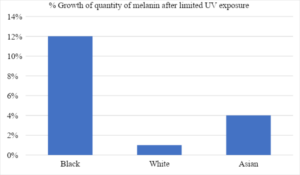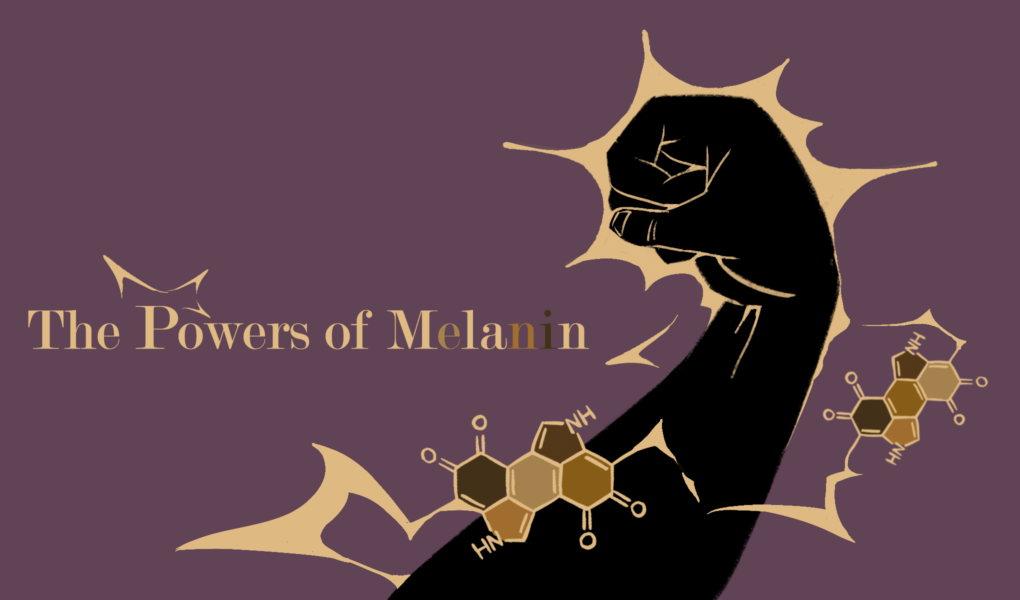Abstract
The molecule in humans that pigments our physical features, called eumelanin, has been known to have electrical properties. Now with advanced technology, there have been groundbreaking studies that have resulted in forms of melanin that have practical conductivity levels. Researchers suggest that the superconductive and semiconductive properties of the material can be harnessed to improve sustainability, innovate bioelectronics, and advance computer technology. Research is novel, however, and there are social implications to consider as we look to melanin as the “wonder substance” of the future.
Introduction
If you are a superhero fan, you might be familiar with Black Lightning, one of the most popular African American superheroes to date. If you are not familiar with him, the important thing to note is that he has the power to manipulate electricity. Another famous black superhero with electric powers is Storm, the overpowered demigod from Marvel’s X-men comics. She has the ability to control the weather, with lightning being one of her most prominent attacks. Other black superheroes include Bumblebee from Teen Titans, Aqualad from Young Justice, Electro from Amazing Spiderman 2, Static Shock from DC Comics, and many others who have something more in common besides their race: electromagnetic powers. While realistically, the trend for Black superheroes with lightning powers is likely a result of Black Lightning’s popularity and early influence in superhero comic culture, particle physicists may provide a deeper insight into the electrical capacity of brown skin.

Figure 1: Eumelanin Molecule
Melanin is the name of a group of molecules in most organisms that provides pigmentation to our bodies. The color our skin, eyes, and lips take on varies by how much melanin we produce. There are three different types of melanin. Neuromelanin colors our neurons. Pheomelanin adds the pinkish tint that we see on our lips and nipples. Eumelanin [Figure 1] determines the color of our eyes, hair, and skin, and it absorbs radiation from the sun to protect against cell damage. This is the type of melanin referred to in the context of race – the more melanin you have in your skin, the darker your skin tone is. Figure 2 presents the percent increase of eumelanin after ultraviolet ray exposure based on race [1]. Black people have the most significant expansion of eumelanin content with sun exposure, which correlates with the pigmentation of their skin. What makes eumelanin stand out in comparison to its siblings is its crystalline structure which has the potential to transfer electric charges fluently. This could open the doors to advanced technology and research, setting up melanin to have greater humanitarian use rather than to divide humans into racial groups that are ranked by false superiority.

Figure 2
Powers of Melanin
Melanin’s ability to conduct electricity is well known in the field of science, with research dating back to the mid-1900s. Not until recently did scientists make breakthroughs in melanin research that could improve technology to new heights. Experiments have shown that melanin can conduct electricity, sometimes with virtually no resistance. Melanin must undergo special conditions to exhibit these characteristics, and once in the proper state, conductive melanin has groundbreaking applications in biotechnology, computing, and sustainability. Coupled with the exciting outlook of melanin’s impact on human quality of life are serious precautions to consider. Previous studies regarding melanin’s presence in the human body have broadly been used to bolster racist systems whose consequences still affect millions. However, there exists a future where history does not repeat itself, and in this future, melanin could find its place at the center of technological innovation.
Melanin has several molecular properties, making it a promising candidate for technological advancement. Melanin provides less resistance in electric flow with an increase in ambient light, and when the molecule is solid, it converts UV rays into nonradiative energy [2]. These qualities result in eumelanin protecting our skin from the sun’s UV rays so we can tolerate prolonged sun exposure without suffering intense skin damage. Melanin is also a material that can both inhibit and promote electric flow, classifying it as a semiconductor. The molecule switches between resistive and conductive states depending on the amount of water in its environment [3]. This “switching” property is a crucial mechanic that builds the backbone of all computers. The different signals in a computer activate tiny switches in intentional patterns to store data, regulate temperature, generate graphics, and perform all other tasks. It’s exciting to think that the semiconductive properties of melanin could open doors for new methods of creating computing systems.
Superconductivity is another property of melanin. Superconductors are special materials that present no resistance in the flow of electrons through their bodies [4]. Superconductors provide many advanced applications for electromagnetic systems, such as enhancing imaging technologies like MRIs and increasing magnetic levitation strength (which is how some of the world’s fastest trains operate today). Melanin has significantly increased other superconductors’ conductivity when doped with other molecules. Magnesium Diboride (MgB2) is a substance that experiences superconductive properties at 39 Kelvin. Like most superconductive materials, MgB2 must be placed in extreme temperature environments to present no resistance to electric flow. MgB2 doped with melanin generates an “excellent enhancement” in the amount of electric current which can flow through the entire compound, meaning that the superconductivity intensifies. Scientists also observed that these characteristics persist at less extreme temperatures than what is needed for MgB2 alone to exhibit superconductive properties [5].
Eumelanin can also exhibit superconductive properties without being combined with other materials, making it versatile by enhancing other superconductors and being one on its own. Magnetic fields ranging from 2,000 to 9,000 gauss have been shown to produce electrical conductivity in dry melanin. This behavior is observed during the interaction between magnetic fluxes and type 2 superconductors, implying that melanin contains superconducting regions at room temperature [6]. This implication creates avenues for superconductive technology to become more efficient as fewer resources would be dedicated to keeping these materials at the extreme temperatures required to present their superconductive properties.
Harnessing the Power
The usefulness of melanin in its natural state is limited by its conductivity levels which need to be stronger to have practical applications in modern tech. However, after being chemically manipulated, melanin’s conductivity can increase by a billion-fold.
One of the reasons why melanin’s natural chemical structure limits its charge-carrying capabilities is that it has a disordered structure. This means that the molecular layers housing its electrons are in a formation that makes it hard for them to move around. Knowing this, scientists began to manipulate this structure to make it more useful in facilitating electron flow. A method typically used to increase the conductivity of metals, called annealing, was the critical piece in unlocking melanin’s electrical potential. Annealing is a process that involves heating a material in a vacuum to temperatures of around 600 degrees Celsius for extended periods [7]. Through this process, the electron-sharing molecular sheets of the material transition from a random orientation to a uniform electron-sharing stack [8].
High Vacuum Annealed Eumelanin (HAVE) is the result of eumelanin after being annealed. In a groundbreaking study published by Frontiers in Chemistry in 2019, Italian researchers achieved a maximum of 318 S/cm for the HAVE conductivity [3]. This level of conductivity is on the magnitude of copper, making it high enough to be practical for modern biotechnological devices. The researchers also reported a strong correlation between the annealing temperature and the conductivity of the eumelanin allowing for a fine-tuning of its conductivity, making it a versatile option based on the electronic application [8].
Innovative Applications
Three primary areas for innovation that melanin can contribute to are the advancement of research into superconductors, the improvement of bioelectronic medical technology, and an increase in sustainable materials. Regarding superconductivity, after being chemically modified, melanin could be a material that maintains its superconducting properties at ambient temperatures. Most superconductors require extreme temperature conditions to exhibit their zero resistance properties, and maintaining these temperatures for extended distances would make the entire system inefficient [9]. Since melanin potentially maintains its superconductivity at ordinary temperatures, it can be implemented in many applications unsuitable for today’s superconductors. Computers would work faster because signals could travel nearly instantly throughout the system. Less energy would need to be dedicated to cooling systems for electronic devices because less resistance means less heat dissipation throughout the device. Electrons would flow much faster in the electromagnets used in generators, leading to a significant increase in electricity generation. We could even create high-energy transportation systems with enough power to reach 14 miles into the atmosphere!
The innovation in bioelectronics stems from the organic nature of eumelanin. All humans produce melanin, so our bodies are naturally familiar with it. This makes it less risky to put melanin-based electronics in our bodies. There would be many health applications for these electronics, such as a brain stimulator to treat Parkinson’s and sensors used to study stem cells [7]. HAVE also has the potential to be integrated into human-computer interfaces to control artificial limbs with great precision [7].
Because melanin is organic, it is biodegradable, leaving virtually no carbon footprint. More melanin in consumer materials and electronics will reduce harmful waste and pollution [10]. Imagine that instead of finding a particular recycling bin that takes electronics or throwing your old computer away to be added to landfills across the globe, we could plant that computer in the ground so that its organic components get released back into the ecosystem. Melanin as a superconductor could also mean innovations in the power systems field. The material could be used as a means to transport electricity to entire cities with virtually no power loss through heat dissipation because of its zero-resistance nature. This would result in less energy waste and more reliable power delivery.
Limiting Factors
It’s thrilling to consider the potential of such a material. However, there are important considerations to make. For one, melanin’s conductivity levels lower as hydration increases. Unlike natural eumelanin, which increases conductivity with an increase in water content, HAVE was found to have a negative correlation between conductivity and hydration [3]. Since the human body has high amounts of water, this could pose a problem for the applications of melanin in human integrated systems.
It’s important to consider the potential impact of melanin’s electrical capacity through new research before accepting the pessimistic outlook of previous findings on its practicality [11]. However, melanin was studied long before its electrical conductivity came into question, which raises the question of what the primary interest of melanin was during this time [12].
Social Implications
In the past, Eumelanin has been studied closely to bolster the scientifically inaccurate theory of eugenics, in which people with more melanin in their skin are considered pollutants in the human gene pool [13]. This has led to centuries of maltreatment of darker-skinned humans, which has had a massive negative effect on society [13]. While melanin may hold the key to advancing humankind, a careless pursuit in analyzing the molecule could again place Black people involuntarily under society’s medical and social microscope. Prescod-Weinstein states, “Melanin isn’t the first site on Black Bodies that became curious when it served the health of non-Black people” [9].
With an increased interest in eumelanin and its potential to be a vital resource to humankind, there comes the looming threat towards my community, the African Diaspora, that we could again be malevolently observed and reduced to what we have to offer versus who we are as people [14]. This does not have to be the case. If we give a voice to all those involved in scientific discovery and research and collaborate with an open mind, we will avoid repeat consequences. Mainstream science is dominated by white males who have generated a culture that teaches us to consider certain people as peripheral subjects in the matter of science [15]. From the janitorial staff that clean research facilities to patients, involuntary or not, to native peoples who have been displaced in the name of science [16], we must be sure to include all individuals affected by the research process in the conversations surrounding and procedures involving the evolution of humankind. As research continues, everyone must have a seat at the table to contribute their ideas and cultivate a future of diverse science with an inclusive purpose.
Further links
“The Physics of Melanin: Science and the chaotic social construct of Race,” https://www.bitchmedia.org/article/physics-melanin/science-and-chaotic-social-construct-race
“Natural pigments inspire scientists to create novel conductors for Biodegradable Electronics,” https://asrc.gc.cuny.edu/headlines/2020/11/natural-pigments-inspire-scientists-to-create-novel-conductors-for-biodegradable-electronics/
“High-tech melanin might help put technology inside our bodies,” https://www.discovermagazine.com/technology/high-tech-melanin-might-help-put-technology-inside-our-bodies
Multimedia Sources
“The Electronic Wonders of Melanin” https://www.youtube.com/watch?v=KifAQBhYgO0
“This is Lurie Daniel Favors: Dr. Chanda Prescod Weinstein: The Power of Melanin”
https://art19.com/shows/this-is-lurie-daniel-favors/episodes/73049eee-5564-41d6-bfeb
-530571cf2db7
Prescod-Weinstein, “The Physics of Melanin,” in The Disordered Cosmos: A Journey Into
Dark Matter, Spacetime, & Dreams Deferred, pp. 93–112.
Key Word: Melanin, Organic, Conductive, Physics, Race, Skin, Superconductor, Semiconductor Sustainability, Social
Corrected Reference List
[1] P. P. Naik and S. N. Farrukh, “Influence of ethnicities and skin color variations in different populations: A Review,” Skin Pharmacology and Physiology, vol. 35, no. 2, pp. 65–76, 2021.
[2] A. B. Mostert, B. J. Powell, F. L. Pratt, G. R. Hanson, T. Sarna, I. R. Gentle, and P. Meredith, “Role of semiconductivity and ion transport in the electrical conduction of melanin,” Proceedings of the National Academy of Sciences, vol. 109, no. 23, pp. 8943–8947, May 2012.
[3] L. Migliaccio, P. Manini, D. Altamura, C. Giannini, P. Tassini, M. G. Maglione, C. Minarini, and A. Pezzella, “Evidence of unprecedented high electronic conductivity in mammalian pigment based eumelanin thin films after thermal annealing in vacuum,” Frontiers in Chemistry, vol. 7, Mar. 2019.
[4] “DOE explains…superconductivity,” Energy.gov. [Online]. Available: https://www.energy.gov/science/doe-explainssuperconductivity. [Accessed: 27-Jan-2023].
[5] S. A. S. Qaid, N. S. Alzayed, M. Shahabuddin, B. A. Al-Asbahi, E. M. Abuassaj, and A. A. Ahmed, “The effect of sintering conditions on the superconducting properties of melanin doped mgb2,” Journal of Magnetism and Magnetic Materials, vol. 552, p. 169213, Jun. 2022.
[6] Cope FW. Discontinuous magnetic field effects (Barkhausen noise) in nucleic acids as evidence for room temperature organic superconduction. Physiological Chemistry and Physics. 1978 ;10(3):233-246. PMID: 733937.
[7] B. Andrews, “High-tech melanin might help put technology inside our bodies,” Discover Magazine, 27-Mar-2019. [Online]. Available: https://www.discovermagazine.com/technology/high-tech-melanin-might-help-put-technology-inside-our-bodies. [Accessed: 23-Jan-2023].
[8] “Scientists have made melanin a billion-times more conductive. this is why that matters,” World Economic Forum, 24-Apr-2019. [Online]. Available: https://www.weforum.org/agenda/2019/04/will-cyborg-circuits-be-made-from-melanin. [Accessed: 19-Jan-2023].
[9] C. Prescod-Weinstein, “The Physics of Melanin,” in The Disordered Cosmos: A Journey Into Dark Matter, Spacetime, & Dreams Deferred, First., New York, New York: Bold Type Books, 2021, pp. 93–112.
[10] “Natural pigments inspire scientists to create novel conductors for Biodegradable Electronics,” The Advanced Science Research Center, 12-Nov-2020. [Online]. Available: https://asrc.gc.cuny.edu/headlines/2020/11/natural-pigments-inspire-scientists-to-create-novel-conductors-for-biodegradable-electronics/. [Accessed: 23-Jan-2023].
[11] L. Migliaccio et al., “Evidence of Unprecedented High Electronic Conductivity in Mammalian Pigment Based Eumelanin Thin Films After Thermal Annealing in Vacuum,” Frontiers in Chemistry, vol. 7, Mar. 2019, doi: https://doi.org/10.3389/fchem.2019.00162.
[12] S. Mosca and A. Morrone, “Human Skin Pigmentation: From a Biological Feature to a Social Determinant,” Healthcare, vol. 11, no. 14, pp. 2091–2091, Jul. 2023, doi: https://doi.org/10.3390/healthcare11142091.
[13] P. P. Reynolds, “UVA and the History of Race: Eugenics, the Racial Integrity Act, Health Disparities,” UVA Today, Jan. 09, 2020. https://news.virginia.edu/content/uva-and-history-race-eugenics-racial-integrity-act-health-disparities
[14] A. Nuriddin, G. Mooney, and A. I. R. White, “Reckoning with Histories of Medical Racism and Violence in the USA,” The Lancet, vol. 396, no. 10256, pp. 949–951, Oct. 2020, doi: https://doi.org/10.1016/s0140-6736(20)32032-8.
[15] M. H. Dancy and A. K. Hodari, “How well-intentioned White Male Physicists Maintain Ignorance of Inequity and Justify Inaction,” International Journal of STEM Education, vol. 10, no. 1, Jun. 2023, doi: https://doi.org/10.1186/s40594-023-00433-8.
[16] S. Borrelle, “Society for Conservation Biology | SCB Opposes Construction of Thirty Meter Telescope on Mauna Kea,” conbio.org, Feb. 21, 2020. https://conbio.org/policy/scb-opposes-construction-of-thirty-meter-telescope-on-mauna-kea




